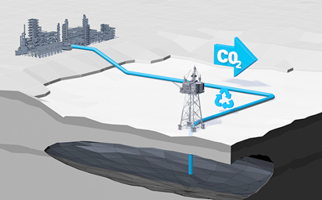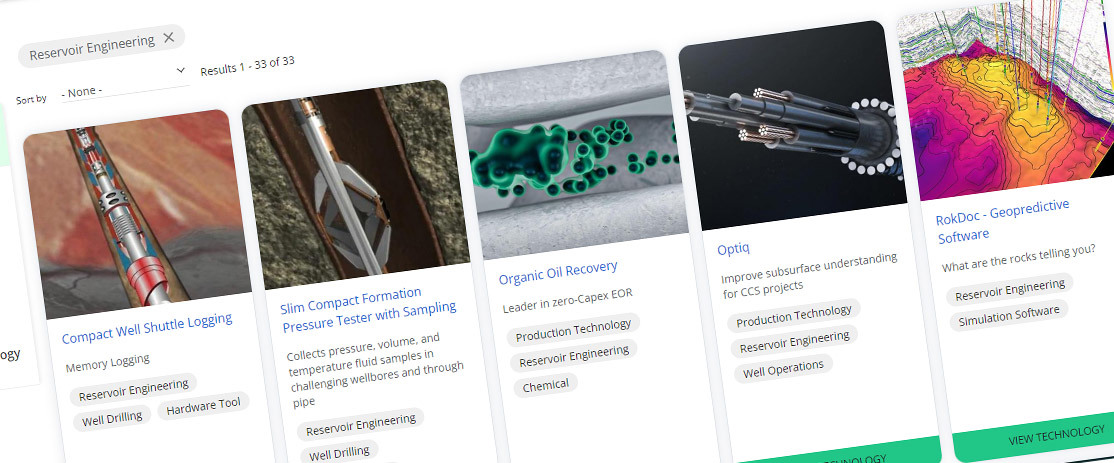With more than 190 technologies reported, and 40% of these in the development or early deployment stage, reservoir and well management is a very active and innovative area in the UKCS technology space.
In 2025, operators reported new technologies focusing on improved recovery, reservoir monitoring and improved well surveillance. These included remote/remedial well surveillance and monitoring of gas flow rate using AI based volume quantification of bubble flow count, management and intervention technologies such as tubing retrievable/retrofit SSSVs, storm chokes for HPHT wells, and water shutoff annular isolation technologies.
Technologies for carbon storage operations are increasing, and hydrogen storage technologies are reported for the first time this year.
There has been a high-degree of deployment in the field, thanks to partnerships between operators and suppliers in applying these solutions to specific requirements.
- The main areas of operators’ technology focus are on improved recovery, intelligent reservoir monitoring, and well surveillance, management and intervention. The number of technologies for carbon storage operations is increasing and two hydrogen technologies are reported this year.
- There is widespread interest in these technologies, with 14 operators carrying at least five reservoir and well management technologies in their plans, 24 operators are reporting at least one technology.
There is a balanced mix of technologies in the development stages in this area, with circa 38% of these being in the deployment stages. Proven technologies make up the balance.
Operators rely on vendors to source the majority of technologies (56%) but are also active in technology development directly and/or in partnership with others.
Readiness definitions: Early development (TRL 1-4), late development/Pilot (TRL 5-7), early commercialisation (TRL 8), proven (TRL 9)
Increased adoption of downhole fibre optic sensing. Wireless downhole pressure gauges also reported and smart monitoring for ESPs endpoint detection response and remote/remedial well surveillance. New this year are a wireline probe for a modular formation dynamics tester, an integrated emissions tracking solution and multi-zone flow indications in drill stem tests. An emerging technology is for hydrogen storage in a depleted gas reservoir.
- Wireline probe for modular formation dynamics tester pressure measurement: The wireline probe is a specialised tool used in the oil and gas industry for fluid extraction and reservoir characterisation.
- TRL 9 commercially available (NEW)
- Virtual metering system: Use of dual gradio pair gauges and reservoir modelling to provide a virtual metering solution.
- TRL 9 commercially available (NEW)
- Downhole fibres/gauges DTS for flow indication: Use of downhole temperature sensors to measure the flow of each zone during a drill stem test avoiding the need for a production logging tool. Also reduces emissions.
- TRL 9 commercially available (NEW)
- Remote/remedial well surveillance: Assesses the application of instrumented wellhead equipment including VR transmitters and wireless downhole instrumentation.
- TRL 9 commercially available
- Distributed acoustic sensing (DAS): Uses fibre optic technology in a number of new reservoir sensing methods. The disposable FLI system uses fibre-optic technology to capture distributed temperature and acoustic measurements along the entire length of the well in real time.
- TRL 9 commercially available
- Smart monitoring for electrical submersible pumps (ESPs): Condition based monitoring and automatic optimisation of ESP wells.
- TRL 9 commercially available
- Virtual metering: Using machine learning for virtual metering and operational envelopes.
- TRL 5-7 late development/pilot
An increase in artificial lift technologies including ESPs and gas lift, with a focus on retrofit devices and alternatively conveyed methods. Reservoir modelling for hydrogen storage, intelligent well technology and a slim pump safety valve. New this year are an axial flow gas handling device, MicroStim micro grained proppant technology, post-perforation treatment, skin breakup and removal treatment. Emerging technologies include jetted deep-penetrating perforation and new tech includes stress cycling stimulation.
- Axial flow gas handling device for submersible pumps: Helps reduce vapour bubble size, homogenising gas-liquid mixture before entering the pump.
- TRL 9 commercially available (NEW)
- Polymer flood: Polymer injection for improved oil recovery in heavy oil field.
- TRL 9 commercially available (NEW)
- Alternative to conventional hydraulic propped fracturing: Low cost and green alternative with a small equipment footprint which can be platform delivered.
- TRL 9 commercially available (NEW)
- Post perforation treatment: Enhanced perforation solution treatment employs a patented dynamic underbalance technique to break up and remove near-wellbore flow impairment damage (typically called skin) from existing perforating tunnels.
- TRL 9 commercially available (NEW)
- Slim pump safety valve (SPSV): Can be incorporated into cable deployed ESPs or jet pump systems providing an API qualified valve with minimal additional system complexity.
- TRL 9 commercially available
- Organic Oil Recovery: Enhanced oil recovery by activating in-situ microbes that reduce interfacial tension between water and oil, breaking down trapped oil into smaller droplets that can be transported through the reservoir.
- TRL 9 commercially available
- Alternate conveyed ESPs/slimline ESPs: Remedial ESPs deployed by coil/cable, investigation and field trial of alternate deployed, e.g., coil/cable, remedial ESP systems, alternate motors, e.g., permanent magnetic.
- TRL 9 commercially available
- Laser perforating: A new technology that uses lasers to perforate rocks. The technology is non-damaging, safe (non-explosive), and affords precise control over the perforation's geometry (size and shape). The process creates an enhanced tunnel that improves the flow and increases production.
- TRL 8 early commercialisation (NEW)
- Stress cycling stimulation: A novel technique to induce multiple repetitive small fractures in wells in order to increase permeability.
- TRL 5-7 late development/pilot (NEW)
- Jetted deep-penetrating perforation: Assessing possible test of jetted 'blood vessel' extended perforations through NZTC collaboration.
- TRL 1-4 early development
Operators are adopting technologies for improving well access for interventions and low-cost workover rigs to reduce the costs, multifunction wireline tools, ultra-high expansion plug for zonal isolation, real time slickline removing the need for e-line wireline equipment, and a lightweight coil hose circulation system. New this year are interventions via derrick, high expansion wireline plug, hydraulic workover unit with rotating base and emerging are the piston operated lubricator systems.
- Interventions via derrick: Perform interventions rig up operations via the drilling derrick to remove the need to install air hoists and eliminate people working at height.
- TRL 9 commercially available (NEW)
- High expansion wireline plug: Fits through restrictions in the tubing string.
- TRL 9 commercially available (NEW)
- Hydraulic workover unit rotating base: HWO unit orientation can vary dependent on well slot and deck space. Previously units could be skidded between slots but not rotated to allow for different configurations, requiring full rig down and rig back up. HWO rotating base solves this issue.
- TRL 9 commercially available (NEW)
- Ultra-high expansion plug: Flexible zonal isolation solution which can be run in flowing wells and set as a platform for cement to be deposited once pressure and flow have abated.
- TRL 9 commercially available
- Use of real time slickline: To save both time and cost by removing the need for e-line wireline equipment.
- TRL 9 commercially available
Digital slickline was selected for a pre-abandonment phase of nine wells (versus a sequential slickline and electric line operation). Provided real-time quality control and data driven decisions across the entire operation.
- Coil hose: Deployment of light weight circulation system to provide a lower cost more efficient alternative to traditional coiled tubing systems.
- TRL 9 commercially available
- Lightweight wireline system: Full wireline spread takes minimum six POB, typically 48 hours+ to rig up and ~24 hours to move between wells. This puts strain on platform schedule/manning. The system is lightweight, unitised and designed for minimum rig up/down time.
- TRL 9 commercially available
The new 90’ LynxTM Wire Line Mast is setting a new industry standard. Introducing superior efficiency, increased working environment and without the need for external cranes once installed. Also features BOP access in compliance with Norsok S-002.

- Safer lubricator system: Raising the lubricator by piston to replace the need to pick it up by gantry crane or air hoist when making/breaking tools. This removes the need to work underneath a suspended load.
- TRL 5-7 late development/pilot (NEW)
- Flow assurance module (FAM): A valve manifold module fixed on the annulus side of the Christmas tree to allow injecting scale inhibitor down to the well without breaking tree cap. This allowed the operator's FPSO to use ROVSV rather than LWIV for scale squeeze with less intervention days.
- TRL 5-7 late development/pilot
The Oilenco UniLOT (Universal Lockout Tool) provides a means to permanently lock-open a tubing retrievable subsurface safety valve (TRSSSV) so that it remains open with no obstruction from the flapper.
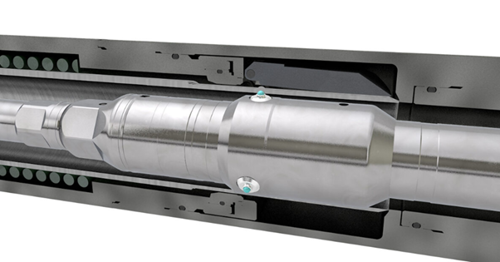
Well integrity repairs continue to show strong innovation in providing solutions for wellhead leakages, tracking well leak paths, tubing retrievable/retrofit SSSVs, storm chokes for HPHT wells, water shutoff annular isolation technologies, swellable seals, and slim pump safety valves. DHSV control line remediation by nano coil. New this year are U-Cup seal modification/replacement. Emerging technology includes intelligent safety valve, pulse actuated downhole safety valve.
- Heated flushing and re-greasing of tree valves: Where valves could not be re-instated by standard remediation procedures. Following the flushing exercise, all valves successfully met the performance criteria, the majority with zero leak rates.
- TRL 9 commercially available
- Gas ingress isolation valve: Used when getting gas returns up control line of downhole SSSV. GIIV prevents gas returning to hydraulic panel by holding positive pressure.
- TRL 9 commercially available
- Novel wellhead sealing for production wells: A time activated sealant is deployed in its liquid phase into the voids of wellhead sealing areas. Once in place, the sealant converts to a resilient, self-bonding and pressure-energised solid material.
- TRL 9 commercially available
A time activated sealant is deployed in its liquid phase into the voids of wellhead sealing areas, the sealant converts to a resilient, self-bonding and pressure-energised solid material that acts to re-establish full integrity of the wellhead.

- Swellable seals: Swellable seals used when gas influx is seen in wireline retrievable SSSV control line. Polished bore of safety valve landing nipple can be damaged and this seal swells in oil or water, creating a seal in the damaged area.
- TRL 9 commercially available
SLB – Wireless downhole safety valve: Wells that require remediation after a (TR-SSSV) failure, or wells originally completed without a subsurface safety valve and now requiring one due changes in policies or regulations.
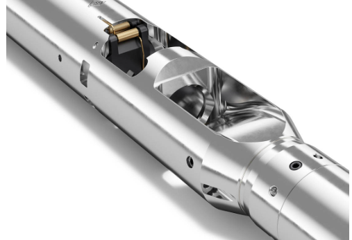
- U-cup modification: Wellhead P-seal repair, typically replacing a u-cup seal with a spring energised P-seal to improve seal integrity and/or service life.
- TRL 8 early commercialisation (NEW)
- Slim pump safety valve (SPSV): SPSV can be incorporated into cable deployed ESPs or jet pump Systems, providing an API qualified valve with minimal additional system complexity.
- TRL 8 early commercialisation
- Intelligent safety valve: Pulse actuated downhole safety valves. Self-contained and self-powered, the ISV does not require any mechanical interface with other surface systems to function. The ISV is designed to send a wireless signal to surface at 24-hour intervals, confirming continued operation without the need of a function test.
- TRL 5-7 late development/pilot (NEW)
- DHSV Control line remediation: DHSV control lines run behind the tubing in a well, but can be a direct conduit to the reservoir if barrier failures occur. Repairs of these can be completed using sealant for low rate leaks, however other currently unable to resolve intrusive issues for deployment into DHSV control lines.
- TRL 5-7late development/pilot
This sub-category includes deployable technologies using mechanical, radio frequency signals and electro-hydraulic pulsing technologies. Emerging technology includes use of kinetic hydrate inhibitors and innovative solutions to inhibit and soften wax and asphaltenes, automated water washing package for halite removal. No new technologies this year.
- Installation of automated water washing package: Enables remote water washing of wells to remove halite. Managed from the control room onshore.
- TRL 9 commercially available (NEW)
- Extended release platform: Leverages a nanotechnology platform to significantly increase production chemical performance while providing a meaningful carbon reduction advantage.
- TRL 9 commercially available
- Innovative wax Inhibitor and dissolver: Green carbon electron sharing technology that weakens the Van der Waals attractive forces for asphaltenes and paraffins allowing a phase change from solid to liquid that effectively controls waxes and asphaltenes at a lower dosage rate both inhibits and dissolves wax.
- TRL 9 commercially available
- Exothermic reactive chemical wax dissolver: An exothermic reactive chemical upon mixing of organic acid and base at certain ratios to achieve temp required to dissolve wax.
- TRL 9 commercially available
- Rotating tool technology: A mechanical scale prevention tool developed for scale protection. It prevents scale from growing across the safety.
- TRL 9 commercially available
- TRL 9 commercially available
- Scale build inhibitor: A surface mounted scale control technology which transmits radio frequency signals along production tubing.
- TRL 9 commercially available
ClearWell examined five North Sea wells and made recommendations for how ClearWELL™ technology could address their calcite scaling. And subsequently installed ClearWell system on the platform.
Technology example link
- Wireline deployed scale removal tool: Wireline deployed high pulse tool for scale removal and production stimulation using electro-hydraulic pulsing (EHP) principles.
- TRL 9 commercially available
Bluespark WASP: Wireline deployed high pulse tool for scale removal and production stimulation.
Technology example link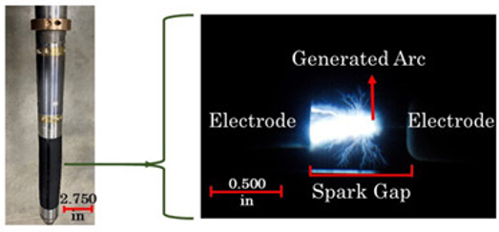
- Kinetic hydrate inhibitors: Prevents the creation of hydrates - allowing for better flow along the pipeline. Kinetic hydrate inhibitors (KHIs) interfere with hydrate crystal growth or nucleation by embedding themselves into the lattice structure, delaying significant growth for longer than the fluid’s residence time.
- TRL 5-7 late development/pilot
This sub-category includes a range of new products to improve flow and trace the production geology of reservoirs. Emerging technologies include improving well water and liner shut off, together with rejuvenation techniques for shut-in wells and water shutoff by annular isolation technologies and expanding polymer grains, offshore slop treatment using ceramic membranes. No new technologies this year.
- Water tracers: Allowing identification of open perforations and also the early identification of water breakthrough from individual zones.
- TRL 9 proven technologies
- Water shutoff: Bismuth based or epoxy resin based isolation technologies.
- TRL 9 proven technologies
Annular isolation sleeve by Isol8: Designed to be run on casing/liner like a centraliser. Left in situ and then melted at well decom stage for annular isolation or when well shows annular integrity issues during production.

- Expanding polymer grain: Pumped into the reservoir to make it expand and fully block permeability, it provides a barrier to barrier, self-healing seal surrounding the wellbore.
- TRL 5-7 late development/pilot
Resolute expanding polymer grain: Pumped into the reservoir to make it expand and fully block permeability, it provides a barrier to barrier, self-healing seal surrounding the wellbore. It blocks perforations, screens and bore space providing a self-healing pre-barrier to plugs and cement.
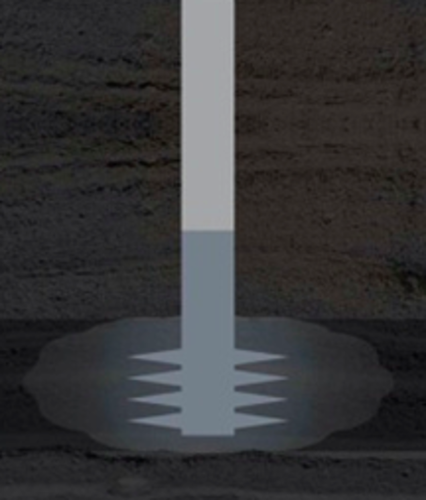
- Horizontal well water shutoff: A study showed the most applicable technologies to use are mechanical plugs to achieve a seal in the wellbore and highly thixotropic polymer gels to achieve a seal in the annulus.
- TRL 1-4 early development
- Deployment of snorkel on wireline: Design of different connector to allow deployment of snorkel on wireline rather than coil.
- TRL 5-7 late development/pilot
Sands and solids management sub-category reported technologies including retrofittable downhole sand screens, porous foam and oil-based gravel packing. Emerging technologies include low-cost sand control completions. No new technologies this year.
- Dual string perforating and retrofitting downhole sand screens: Interventions in two wells during 2020 to shutoff water from the lower reservoir, and access attic oil behind the production casing. The latest perforating technology was tested to achieve the required penetrations of the tubing and production casing set across the upper reservoir section. Downhole sand control using ceramic will be deployed, as conventional steel screens would likely be cut by the velocity of production through the perforated tubing/casing.
- TRL 9 commercially available
Ceramic sand screens from 3M showed enhanced longevity in comparison with steel screens in an extreme hardness erosion test. The 3M ceramic sand screen systems were more resistant to chemical attack by fluids such as hot sulfuric acid, aggressive completion fluids and other corrosive chemicals used in the oil and gas operations industry.

- Porous foam that set around liner for sand control.
- TRL 9 commercially available
- Oil based (NAF) gravel packing: Increased productivity in low net to gross reservoirs.
- TRL 9 commercially available

